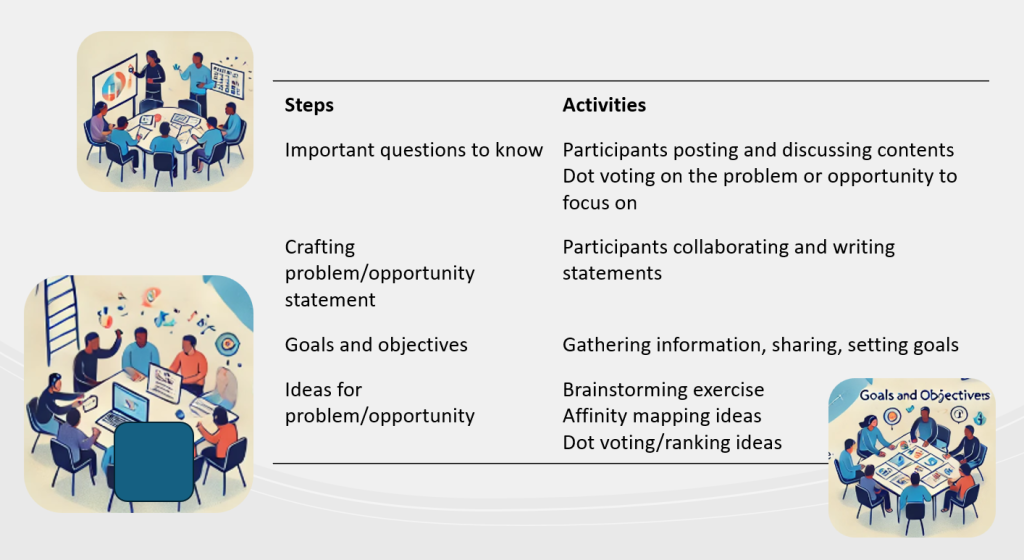Designing UX Discovery and Workshop
I proposed a UX Discovery workshop to the product and portfolio managers, and it was one of the few UX ideas got included in the PI planning. Leading this initiative, I guided teams to address their top priorities intentionally and effectively. This approach empowered data-driven decisions and ensured stakeholder alignment.

As a UX researcher supporting the Pendo Center of Excellence (COE) team and other product teams, I noticed recurring pain points during agile retrospectives: the team’s bandwidth was stretched thin when simple requests turned into urgent fires.
The SharePoint intake form captured only surface-level details, often leading to misaligned expectations and last-minute adjustments.
To address this, I proposed a UX discovery exercise to better understand project requests, clarify technical and UX requirements, and assess urgency and impact. The goal was to foster a shared understanding among teams, boost engagement, and support intentional, data-driven decision-making.
The visuals on this page were tweaked due to confidentiality.
- Identify and articulate the key problems and needs behind project requests.
- Improve the effectiveness and intentionality of Pendo implementations.
- Foster data-driven decision-making for both Pendo and requesting teams.
- Enhance team engagement and ownership of projects.

Problem Statement Discovery
Leveraging Nielsen Norman Group’s problem statement discovery framework, I expanded on the initial intake form with more questions, similar to the 5Ws, to dig deeper into the request’s context. Some questions included:
- What is the current strategy(UX, Pendo, etc)?
- What assumptions are we making?
- What are the key impacts and problems?
The team may have one or more topics. Once we gather most of the answers to the questions, or the team feels they have a solid understanding of the background, current state, and impact of the problem, it’s time to construct the problem statement.
Goal Setting
To help teams set measurable goals, I included questions aimed at defining OKRs (Objectives and Key Results) and related metrics. This ensured both the Pendo COE team and product teams could gauge the success of the implementation and make necessary adjustments.
Brainstorming
The final part of the exercise involved brainstorming solutions for identified problems or opportunities. This collaborative approach helped uncover user segments, needs, pain points, and success measures.
Taking a Step Back to Move Forward
With the interest gathered, I identified three product teams within the Pendo partnership that were eager to try out the discovery excercise. Each team set up sessions to complete the exercise or planned to revisit it when starting new projects. One product team, undergoing revolutionary changes, served as the first “beta user.” The PM, UX, and technical leads participated the workshop to share their roadmap, objectives, and stakeholders. At the end of the exercise, both Pendo and the product teams were pleased with presenting everything in an accessible format that allowed everyone involved to strategize solutions without any blind spots. By reflecting on the bigger picture, both teams decided that progress is best achieved by taking a step back to review their OKRs and roadmap before making additional requests to the Pendo team. This helped the Pendo COE team to have a more realistic timeline of the requests, enabling them to allocate resources for this product in future PI planning more effectively.
An unexpected use for the Content Strategy Team
The content strategy team also showed interest for UX discovery exercise as well. After a content strategist advocated for its use, the Content Strategy Director reached out personally to leverage the board for their team. Given their limited number of strategists and the overwhelming volume of requests, the team often struggled to manage resources effectively. I walked them through the board, suggesting adaptations for their specific use case.
Enhanced Team Engagement and Strategic Decision-Making
The Mural Board significantly boosted team engagement and ownership of project requests by involving members in the detailed discovery process. This approach ensured that Pendo requests were intentional, preventing the misuse of guides as quick fixes and promoting thoughtful, strategic implementations. Additionally, the comprehensive information gathered empowered both the Pendo team and requesters to make data-driven decisions, ensuring a clear understanding of the project’s urgency and impact for more informed actions.
Feedback from beta groups led to several enhancements, including:
- Adding optional questions to cater to different use cases.
- Establishing ground rules for initial questions to maintain focus.
- Introducing an opportunity statement option.


Product-Level Improvements
By ensuring alignment and a clear understanding of the project’s urgency and requirements, the UX Discovery board and workshop helped the product team solve the right problems at the right time. This alignment was key to avoiding blind spots and ensuring strategic focus.
Process Improvements
Streamlined the project intake process for the Pendo COE team and proved adaptable for various other teams. It polished our resource allocation process and demonstrated its value across different use cases, encouraging broader adoption.
Strategic Alignment
The exercise promoted setting measurable goals and tracking progress, which was crucial for maintaining agility amidst overwhelming requests. This strategic alignment ensured that projects were continuously evaluated and adjusted, leading to more effective and intentional outcomes.
When proposing new processes or initiatives, share your work with a small group of trusted allies to gather genuine feedback and extend its impact. Treat your research methods like a product by testing them with different teams to accommodate varying needs, ensuring flexibility and respecting their timeline. Remember, even a great process may not work if the team isn’t ready to engage openly.